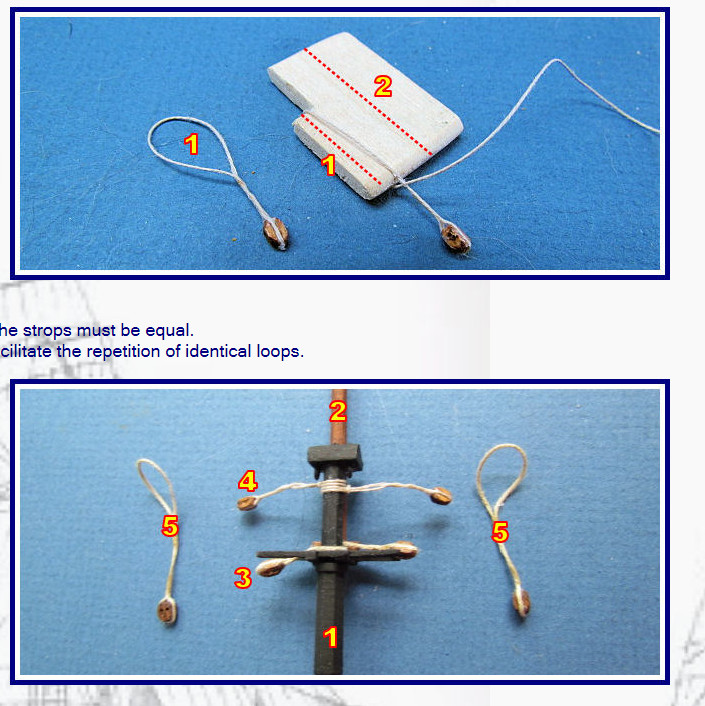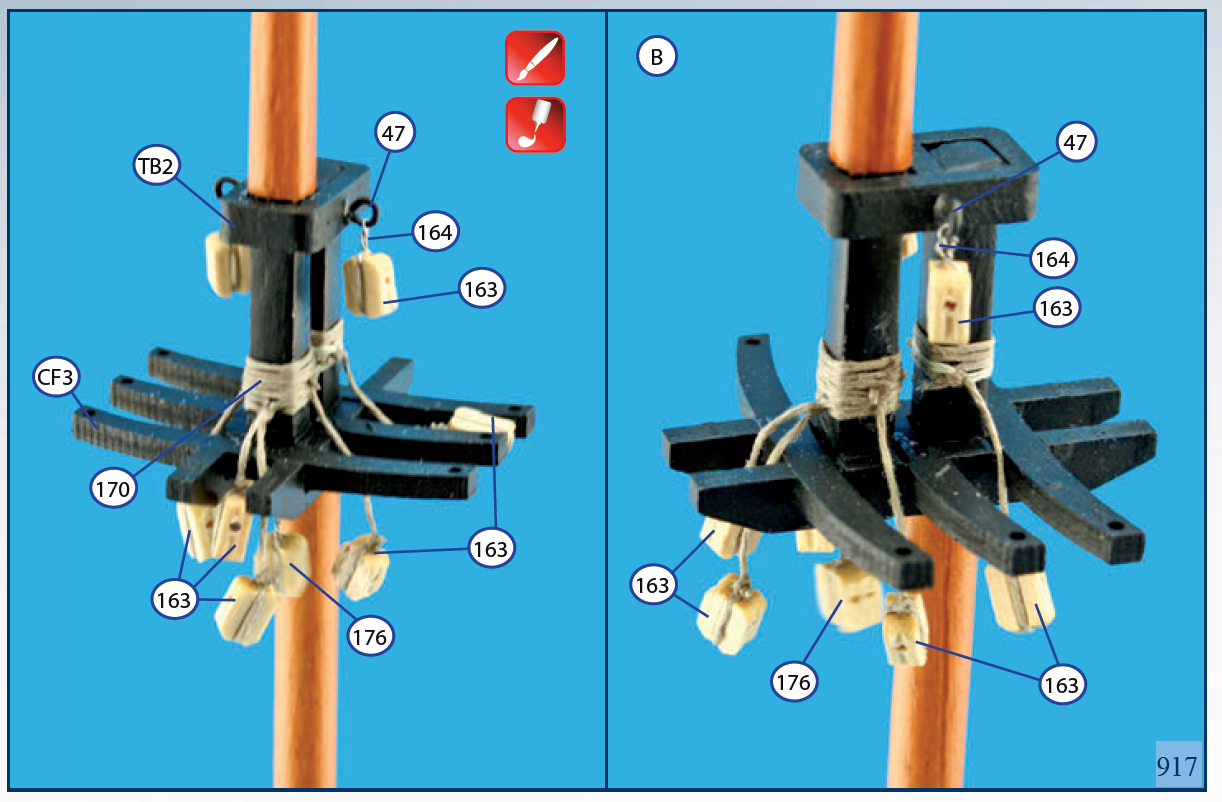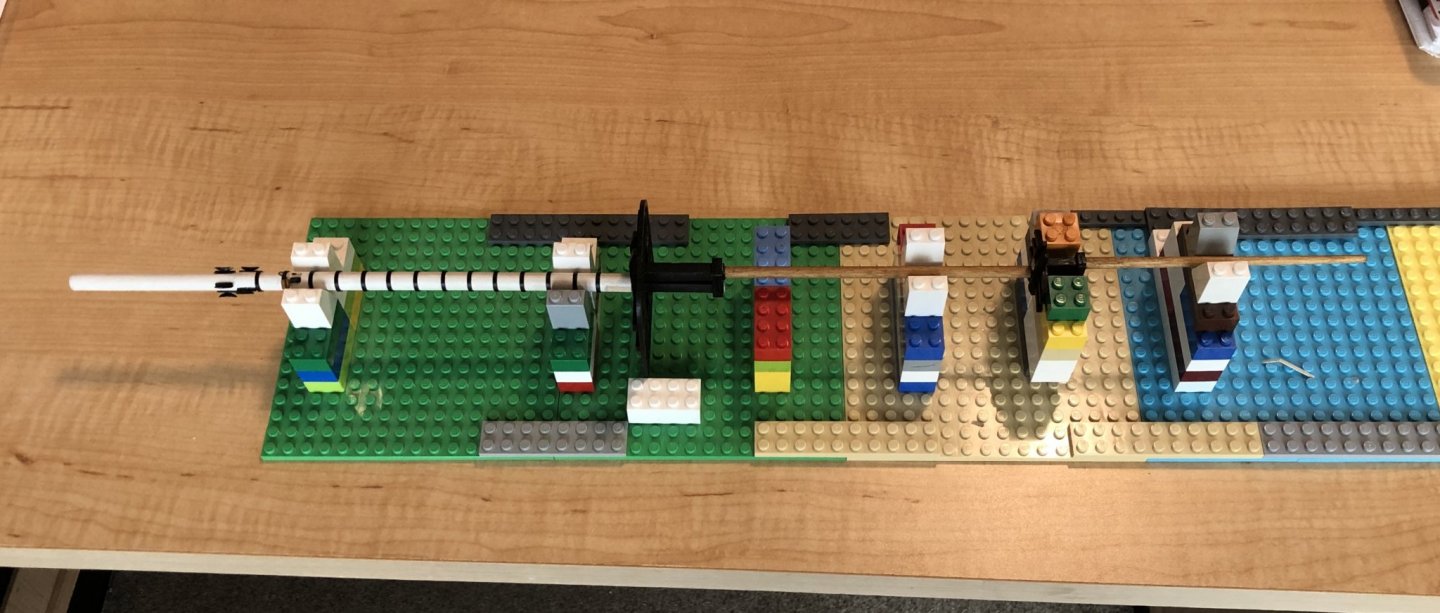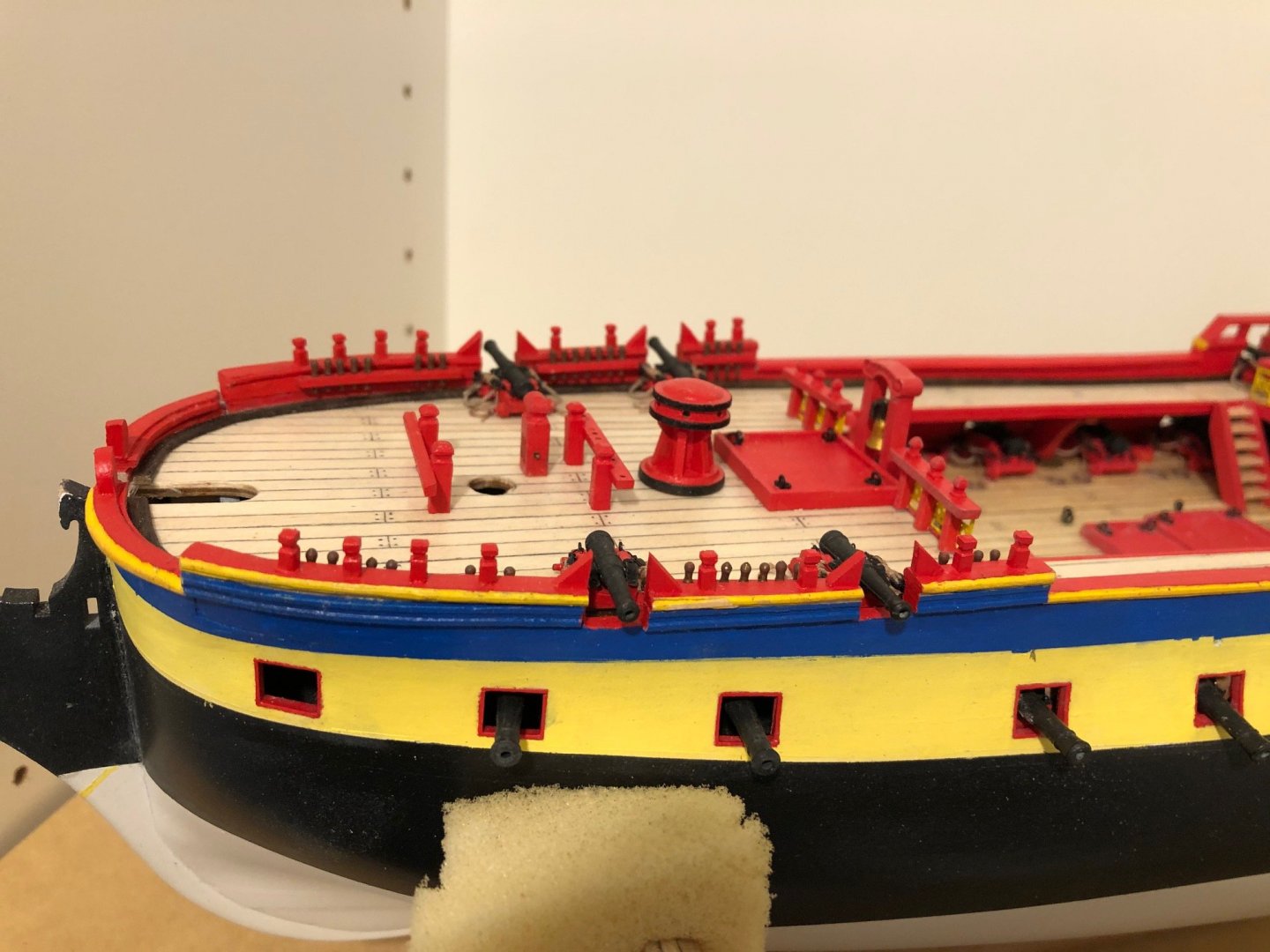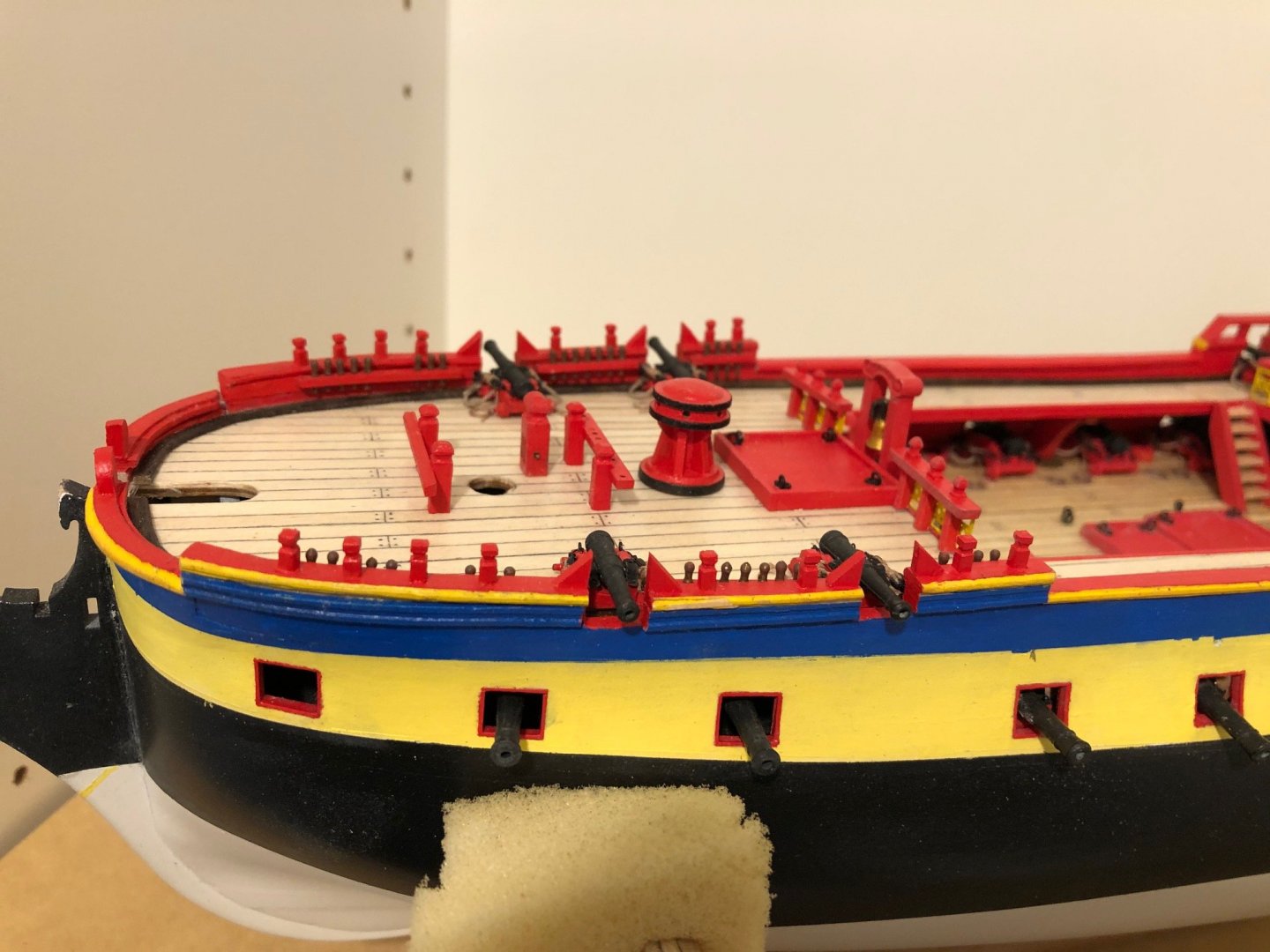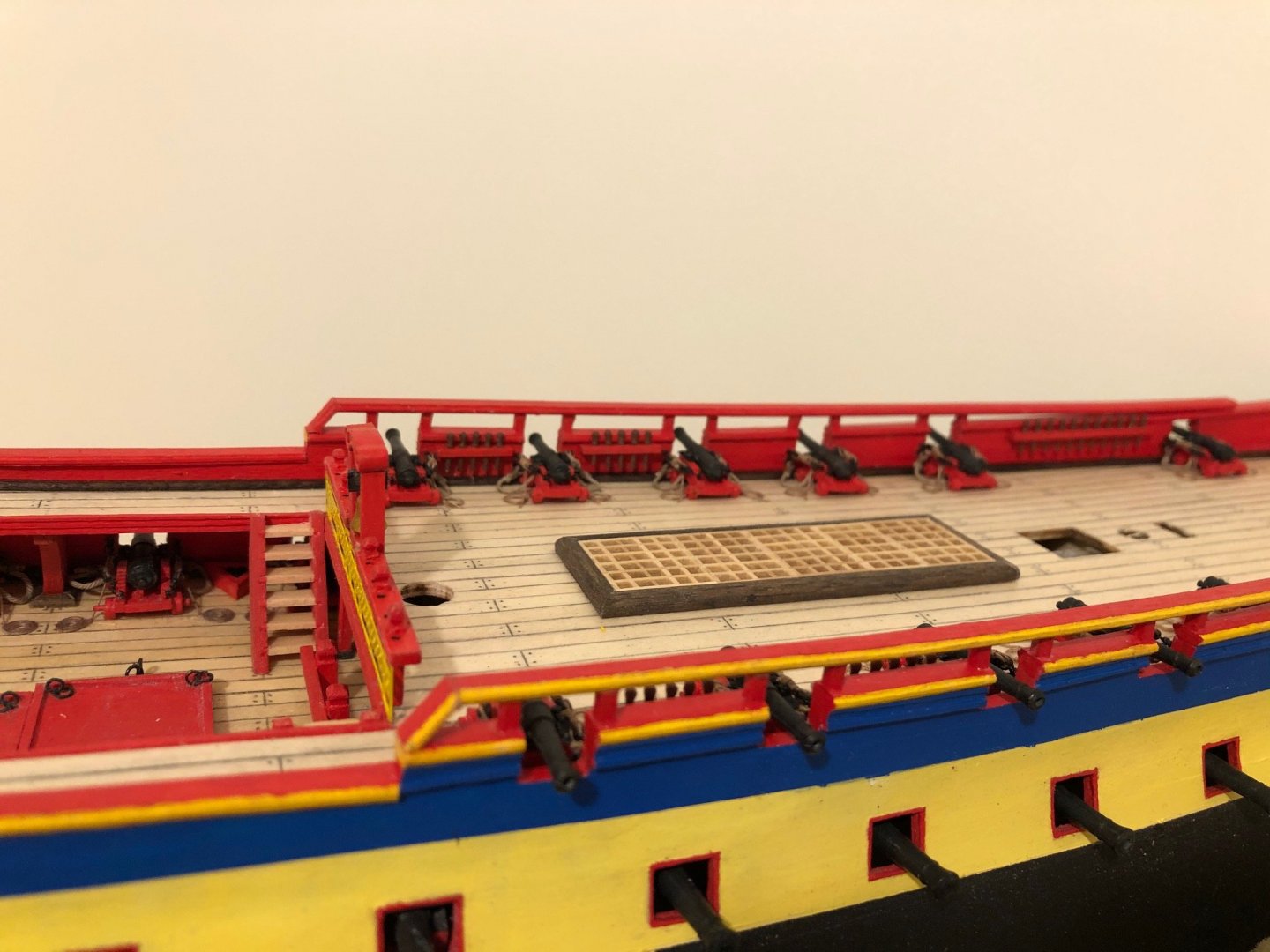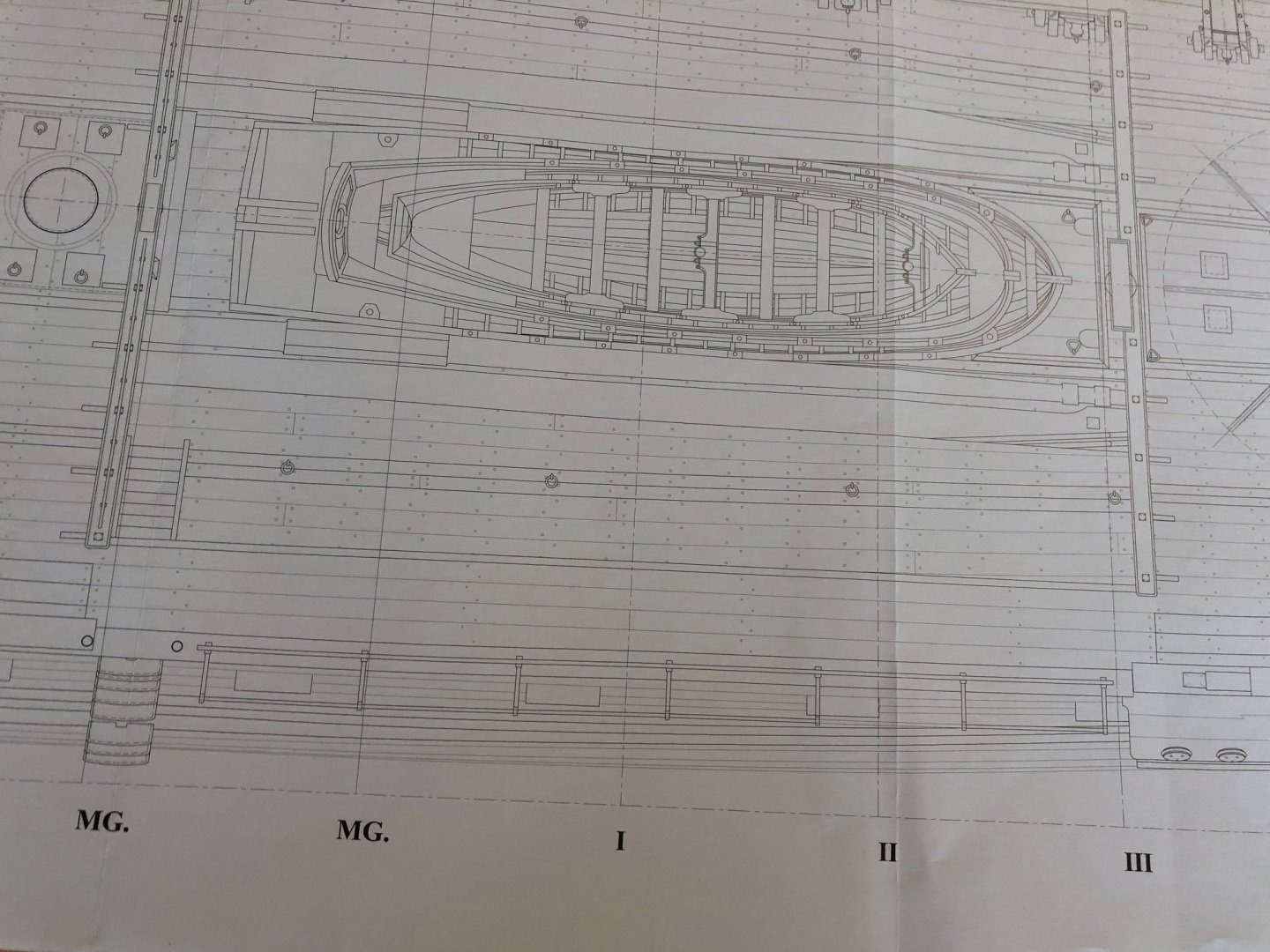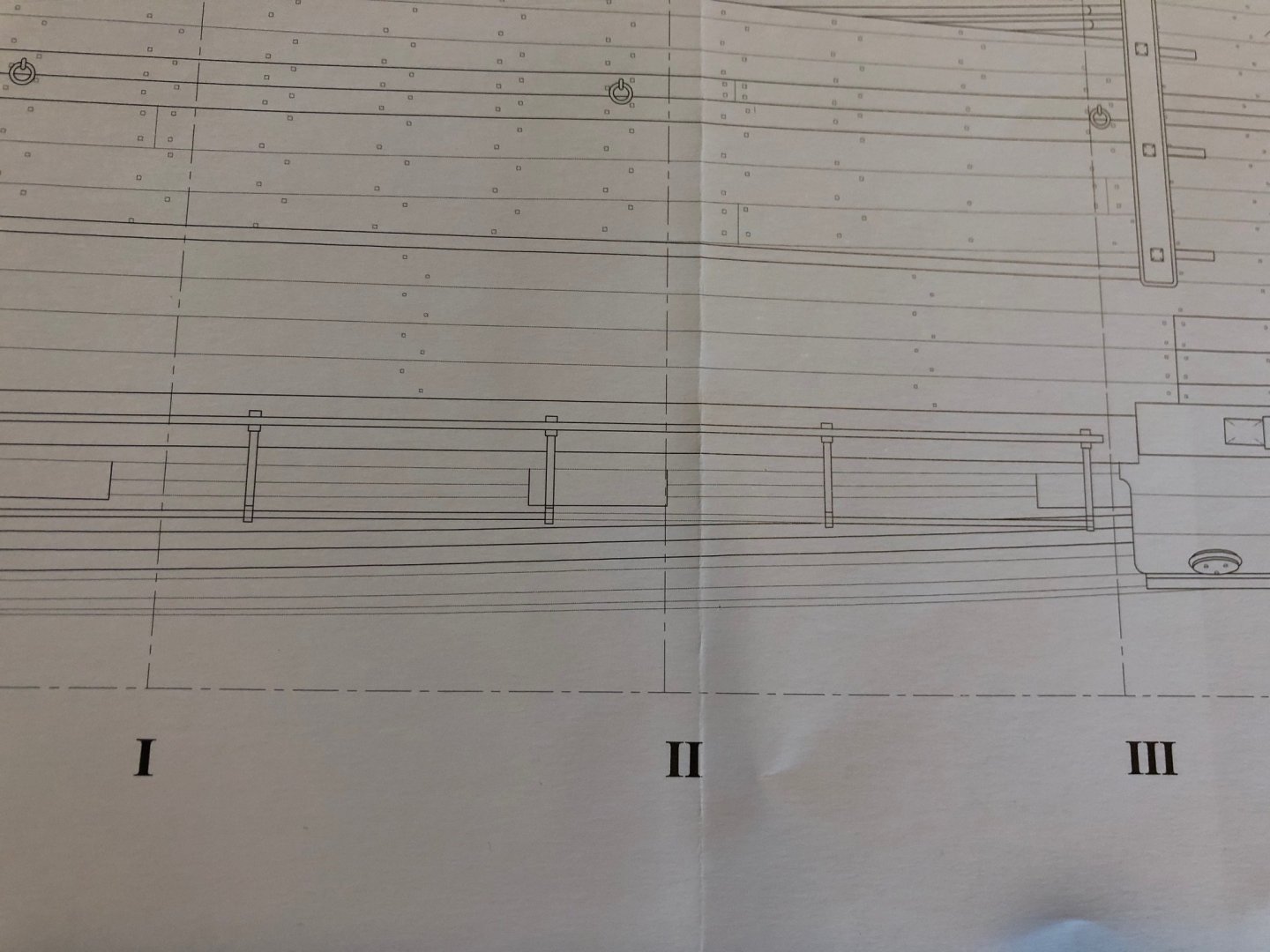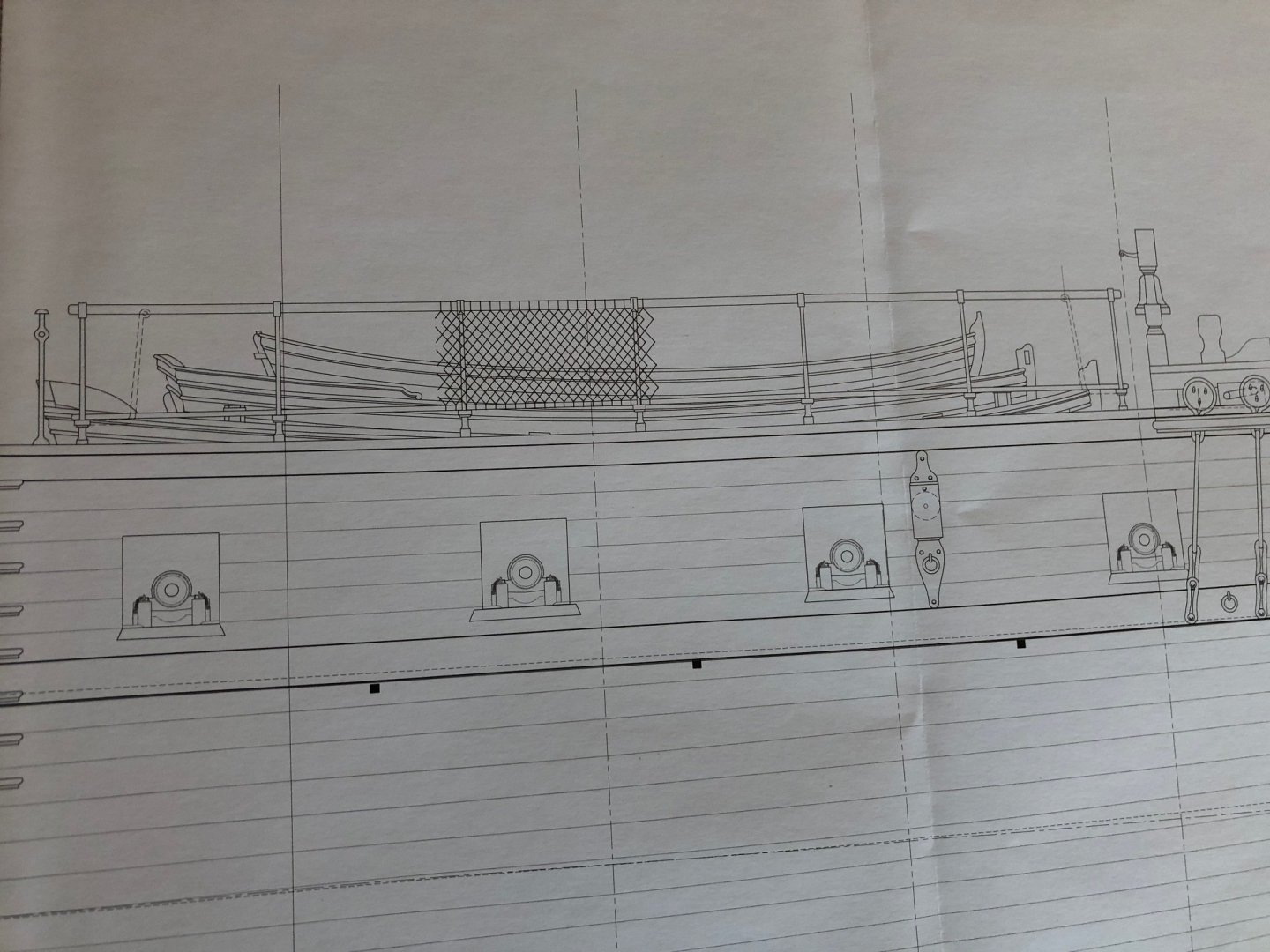
Spike1947
Members-
Posts
39 -
Joined
-
Last visited
Profile Information
-
Location
Portland, Oregon USA
Recent Profile Visitors
The recent visitors block is disabled and is not being shown to other users.
-
 Archi reacted to a post in a topic:
Hermione cannon rigging
Archi reacted to a post in a topic:
Hermione cannon rigging
-
 mtaylor reacted to a post in a topic:
AL L'Hermione - How to rig blocks at mast crossings
mtaylor reacted to a post in a topic:
AL L'Hermione - How to rig blocks at mast crossings
-
AL L'Hermione - How to rig blocks at mast crossings
Spike1947 replied to Spike1947's topic in Masting, rigging and sails
Thanks Allen for your reply. The numbers in the illustration are just part numbers. The only really relevant numbers are 163 - single block and 176 - double block. I take your point about the large number of blocks connect to the foot of the topgallant mast. I know enough to know that this is a mast that was often unshipped in bad weather conditions. Your broader point about the general accuracy of the block placement is what troubles me the most. regarding your remark about how the blocks would be attached I think the picture below may illustrate what you are suggesting. This are spliced loop for each block. I can see how that would be a secure arrangement but I struggle with the practicality - the the modeling application - of getting the lengths correct knowing that one block would attach above another. Rich -
I find myself continually bumping up against my ignorance. I feel pretty good about getting my masts assembled to be straight. Now I'm adding the various blocks that will be part of the running rigging. There are a number of blocks - see picture below - that are attached to the one mast or the other between the cross trees and the cap. I cannot make out what knot to use to properly attach those blocks to the mast. Can I please get some advise on how to rig these blocks in an authentic way? Thanks, Rich Klecker
-
 mtaylor reacted to a post in a topic:
AL L'Hermione - LEGO jig for alignment of stepped masts
mtaylor reacted to a post in a topic:
AL L'Hermione - LEGO jig for alignment of stepped masts
-
 Matrim reacted to a post in a topic:
AL L'Hermione - LEGO jig for alignment of stepped masts
Matrim reacted to a post in a topic:
AL L'Hermione - LEGO jig for alignment of stepped masts
-
 Keith Black reacted to a post in a topic:
AL L'Hermione - LEGO jig for alignment of stepped masts
Keith Black reacted to a post in a topic:
AL L'Hermione - LEGO jig for alignment of stepped masts
-
 Ryland Craze reacted to a post in a topic:
AL L'Hermione - LEGO jig for alignment of stepped masts
Ryland Craze reacted to a post in a topic:
AL L'Hermione - LEGO jig for alignment of stepped masts
-
 RichardG reacted to a post in a topic:
AL L'Hermione - LEGO jig for alignment of stepped masts
RichardG reacted to a post in a topic:
AL L'Hermione - LEGO jig for alignment of stepped masts
-
I posted a question a few days ago about alignment of stepped masts. I got several good replies but I still felt like I need something more. A visit with my five-year-old grandson gave me the inspiration I needed. LEGO! They are nearly infinitely adjustable, supply a stable and rectilinear base, and my grandson has approximately a million of them. Anyway, a picture is worth a thousand words. Here's the main mast of my L'Hermione just about finished up.
-
 Ryland Craze reacted to a post in a topic:
AL Hermione - Build the masts before or build them step-by-step
Ryland Craze reacted to a post in a topic:
AL Hermione - Build the masts before or build them step-by-step
-
 BobG reacted to a post in a topic:
AL Hermione - Build the masts before or build them step-by-step
BobG reacted to a post in a topic:
AL Hermione - Build the masts before or build them step-by-step
-
Thanks to everyone for quick replies to my distress call. Glenn summarizes it well and underscores my level of anxiety. I guess the optimistic takeaway is that either approach can work if correctly applied. As a novice to this ship model building experience my worry is the "if correctly applied" part. For those of you that use the method of completing the stepped masts before placing them on the ship I have a question. besides straight line guides and plumb lines has anyone devised any type of jig that could help with alignment as the various mast elements are added? Thanks again for you comments.
-
 mtaylor reacted to a post in a topic:
AL Hermione - Build the masts before or build them step-by-step
mtaylor reacted to a post in a topic:
AL Hermione - Build the masts before or build them step-by-step
-
After many months I am now at the point of putting masts on the model and I can't make myself get started. I'm building AL's L'Hermione. I have cut and tapered the masts, they're painted and some of the blocks are installed. The AL instructions for this portion of the build are very abbreviated - read just pictures, no descriptions at all. The picture show the details for the individual masts and then it shows the masts assembled and ready to be placed into the hull. As I think about how I would assemble an entire mast I begin to wonder how that mast can be built to be straight and the individual masts properly aligned with each other. I've searched through the many contributions on this and related topics. It seems like there is a strong preference by many to install individual masts, attach the relevant standing rigging and then move up the mast; mast, then top mast, then topgallant mast. My concern with this approach is that as you work up the mast assembly you start working "in the air" with fewer and fewer reference points regarding alignment and plumb. Can I please get some help or guidance about how to proceed here. I need a push. Thanks
-
Thank you "michelsr" for your comment. You are correct that this information arrives "after the battle". You might say "that ship has sailed". I chose to go with the full compliment of cannon as provided by the AL kit. I do have some regrets about that decision because probably does not represent a historically correct distribution on armament for the ship. Nonetheless the main deck full of cannon has a good look to it.
-
Chapman, the monograph has several pages of text and illustrations in a section devoted to "Hermione's Artillery"". There is no mention of obusiers/carronades. Oddly, Plate No. 21, "Castles and their furniture", shows what appear to be two obusiers on each side of the quarter deck opposite the companionway hatch. At one time I had considered trying to find some carronades of the correct scale to place in those positions but eventually decided against it. As I've mentioned before, I like Christos/Messis have struggled with how far to diverge from the kit and when and where to pick my battles regarding historical accuracy. Richard
-
Thanks Christos for the comment and illustrations. Maybe your comment about the absence of hammock rails on frigates in particular helps to resolve the issue. We've seen hammock rails but they seem to be on ships-of-the-line. One of my considerations is the one you mentions regarding the scale of the AL model (1/89). That particular issue moves me toward the "don't do it" side of the question. Happy new year to your as well Christos. Richard
-
Well, this has certainly turned out to be an interesting discussion. My thanks to mtaylor, cotrecerf and now Chapman for the research. I think we can agree that there is some documentary evidence - from the French naval regulations - and evidence from several models that hammocks were used and stored in hammock nets around the time Hermione was in commission. I guess there's a question about how close to contemporary the models are but they are certainly useful. Now I must go back to Mark's comment, "Go with what you feel". As a first time scale wooden ship modeler I don't want to add more difficulty to an already challenging project. On the other hand the kit needs deep scrutiny and improvements as Messis as demonstrated so well. I certainly feel like I have the information I need to make the call. Thanks again for your interest and advice. This feels like a great demonstration of the power of community like the one this forum fosters. Richard
-
I know this post is now several months old now but I wanted to add to it. My family was thoughtful enough to give me a copy of the ANCRE Hermione monograph. There are several discussions in the volume about how the French frigates were armed. Specifically how the main deck - forecastle and quarter deck - were equipped with the 6-pound cannon. Evidently a driving consideration was the number of 6-pound cannon and their affect on the center of gravity. The answer was to pierce the quarter deck bulwark with six gunports per side and the forecastle with four gunports per side. Just as the Hermione model shows. But the quarter deck was armed with only three cannon on each side and the forecastle with just one cannon per side. This allowed the ship to have only half the number of guns on the main deck as compared to gunports. When in action the guns from the side that did not bear on the enemy were moved the fighting side of the ship. There is a quote from a naval cadet serving on the Hermione on 7 June 1780 that confirms the movement of guns across the ship that's worth including here: "the enemy having moved from starboard to larboard, we also had to move the castle guns; our men rushed to the pieces in order to effect this more rapidly. We had not taken the precaution of lifting the trip-cord that connects to the firing mechanism; it became caught under a gun truck and the gun fired among us. Like the others, it was loaded with a roundshot, a barshot and grapeshot. One man was killed in the accident and several others were wounded." The quote is not a great recommendation for the "shared cannon concept" but it does seem to support that such a plan was implemented on the Hermione. Richard
-
Thanks cotrecerf for your comment and reference information regarding the French use of hammocks. The original French reference certainly suggests the use - and regulation of use - of hammocks in the French navy. This is the first real documentation I've seen that describes the use of hammocks during that time period. Most of the responses I've seen here and elsewhere tended toward the absence of hammocks for the time in question. Now I'm really wondering how to proceed. One temptation is to ignore the hammock issue completely and just build that part of the kit as described in the instructions. At this middle stag of the kit completion the number of inaccuracies and historical contradictions are beginning to add up. My novice model ship builder brain is not handling it well. Beste Wünsche für das neue Jahr Richard
-
Thanks Mark for your comments. Given the disparity in experience in all things model ship building between yourself and me I hesitate to argue. But, I think the side view you refer to is consistent with either a single rail or the double rail depicted in plan view. Two uprights in line with each other, as shown in the plan view, would be portrayed as a single upright in a side view. My thinking is that the side view depiction of netting along those rails also supports the possibility that those are hammock railings. Wouldn't a simple "guard rail" have a single wooden rail at the top of the uprights? Also, Happy New Year Mark to a fellow Oregonian. Richard
-
Thanks for the reply Mark. The question about if and when the French navy used hammocks is one that seems to come up repeatedly. That surprises me because it make me wonder what the sleeping arrangements were for the crew if it was not hammocks. Did they just curl up on the deck? From what little I've read on this question most of it seems to lean toward the "no hammocks" side of the issue. If that's the case then it will be easy enough to dismiss whatever it is that's depicted in the Hermione monograph drawings as a mistake. I also take your point about the position of railings and the apparent overhang. From my limited experience it seems that the hammock cranes are typically centered on the railings. That full overhang position would certainly make the issue of protecting the hammocks from the weather even more problematic. Richard
-
Thanks Mark and Frankie for the replies. I'm basing my hammock cranes question on the scale drawings that are included in the Ancre monograph about the Hermione. I have included two images of a portion of Plate 21 which is a plan view. It looks to me like there is a fixture on the bulwark railing at the waist along the gangway that is attached to that railing on one side with the other side extending outboards of the railing. Plate 24, which is a profile view, shows netting attached to those fixtures. Those two bits of information is all I have to support the possible presence of hammock cranes on the original Hermione. One of the things that I continue to struggle with is the question of which version of the Hermione, the original or the modern replica, I'm trying to build. The AL kit is definitely a mash-up of the two. I wonder if the modern replica is without hammock cranes for the simple reason that hammocks are not used for the crew of that ship. Richard
About us
Modelshipworld - Advancing Ship Modeling through Research
SSL Secured
Your security is important for us so this Website is SSL-Secured
NRG Mailing Address
Nautical Research Guild
237 South Lincoln Street
Westmont IL, 60559-1917
Model Ship World ® and the MSW logo are Registered Trademarks, and belong to the Nautical Research Guild (United States Patent and Trademark Office: No. 6,929,264 & No. 6,929,274, registered Dec. 20, 2022)
Helpful Links
About the NRG
If you enjoy building ship models that are historically accurate as well as beautiful, then The Nautical Research Guild (NRG) is just right for you.
The Guild is a non-profit educational organization whose mission is to “Advance Ship Modeling Through Research”. We provide support to our members in their efforts to raise the quality of their model ships.
The Nautical Research Guild has published our world-renowned quarterly magazine, The Nautical Research Journal, since 1955. The pages of the Journal are full of articles by accomplished ship modelers who show you how they create those exquisite details on their models, and by maritime historians who show you the correct details to build. The Journal is available in both print and digital editions. Go to the NRG web site (www.thenrg.org) to download a complimentary digital copy of the Journal. The NRG also publishes plan sets, books and compilations of back issues of the Journal and the former Ships in Scale and Model Ship Builder magazines.

